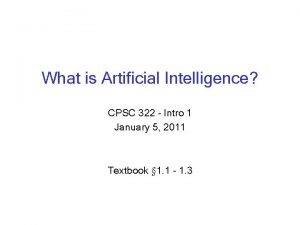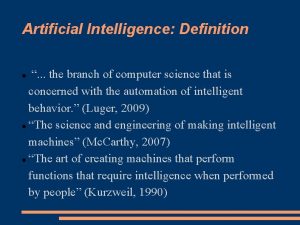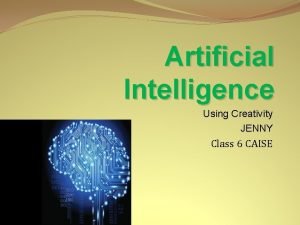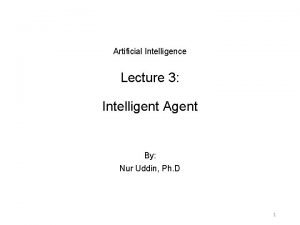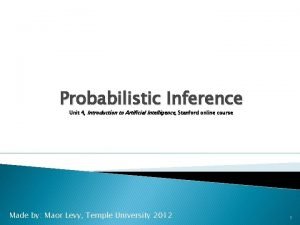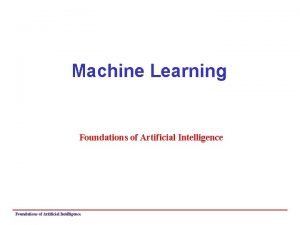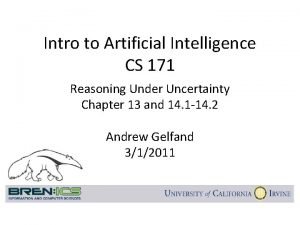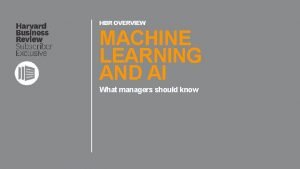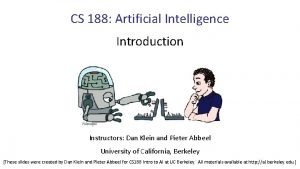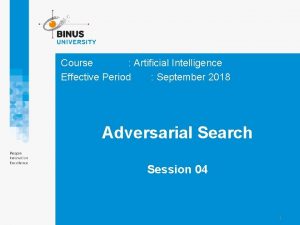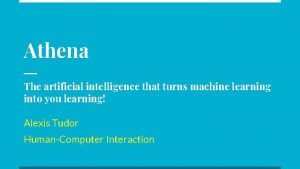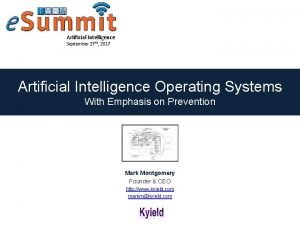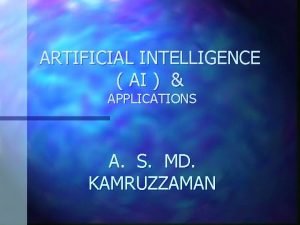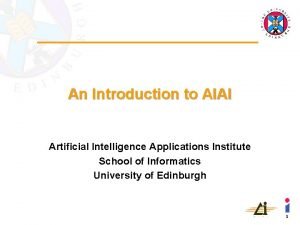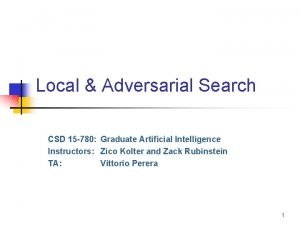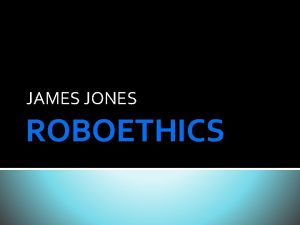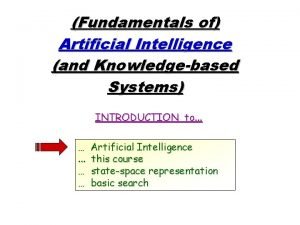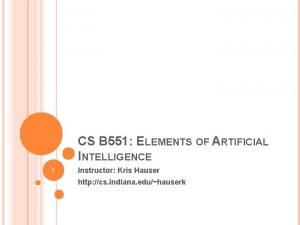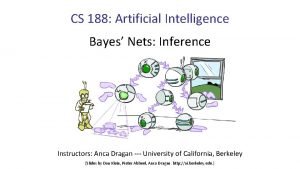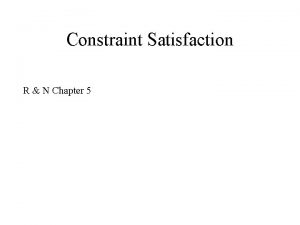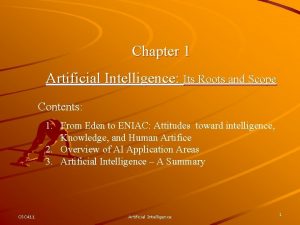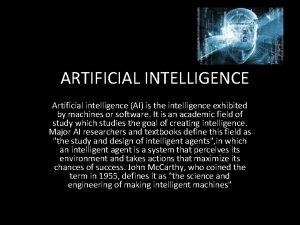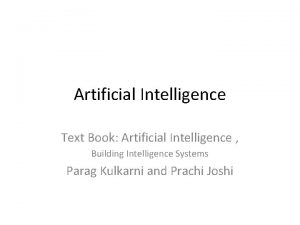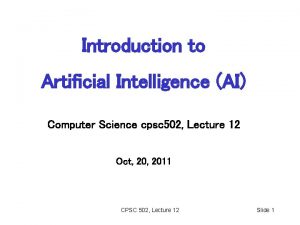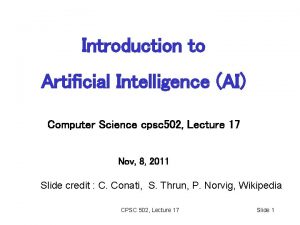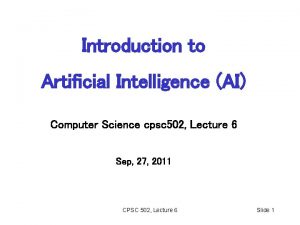Introduction to Artificial Intelligence AI Computer Science cpsc





















































- Slides: 53

Introduction to Artificial Intelligence (AI) Computer Science cpsc 502, Lecture 4 Sep, 2011 CPSC 502, Lecture 4 Slide 1

Systematically solving CSPs: Summary • Build Constraint Network • Apply Arc Consistency • One domain is empty • Each domain has a single value • Some domains have more than one value • Apply Depth-First Search with Pruning • Split the problem in a number of disjoint cases • Apply Arc Consistency to each case CPSC 502, Lecture 4 Slide 2

Limitations of Systematic Approaches • Many CSPs (scheduling, DNA computing, more later) are simply too big for systematic approaches • If you have 105 vars with dom(vari) = 104 • Systematic Search • Constraint Network • but if solutions are densely distributed……. CPSC 502, Lecture 4 Slide 3

Today Sept 20 Stochastic Local Search (SLS) • Local Search & Constrained Optimization • SLS variants • Comparing SLS CPSC 502, Lecture 4 4

Local Search: General Method Remember , for CSP a solution is a possible world • Start from a possible world • Generate some neighbors ( “similar” possible worlds) • Move from the current node to a neighbor, selected according to a particular strategy • Example: A, B, C same domain {1, 2, 3} CPSC 502, Lecture 4 Slide 5

Local Search: Selecting Neighbors How do we determine the neighbors? • Usually this is simple: some small incremental change to the variable assignment a) assignments that differ in one variable's value, by (for instance) a b) c) value difference of +1 assignments that differ in one variable's value assignments that differ in two variables' values, etc. • Example: A, B, C same domain {1, 2, 3} CPSC 502, Lecture 4 Slide 6

Selecting the best neighbor • Example: A, B, C same domain {1, 2, 3} , (A=B, A>1, C≠ 3) A common component of the scoring function (heuristic) => select the neighbor that results in the …… - the min conflicts heuristics CPSC 502, Lecture 4 Slide 7

Queens in Chess Positions a queen can attack CPSC 502, Lecture 4 Slide 8

Example: n-queens Put n queens on an n × n board with no two queens on the same row, column, or diagonal (i. e attacking each other) CPSC 502, Lecture 4 Slide 9

n-queens, Why? Why this problem? Lots of research in the 90’ on local search for CSP was generated by the observation that the run-time of local search on n-queens problems is independent of problem size! CPSC 502, Lecture 4 Slide 10

Constrained Optimization Problems So far we have assumed that we just want to find a possible world that satisfies all the constraints. But sometimes solutions may have different values / costs • We want to find the optimal solution that • maximizes the value or • minimizes the cost CPSC 502, Lecture 4 Slide 11

Constrained Optimization Example • Example: A, B, C same domain {1, 2, 3} , (A=B, A>1, C≠ 3) • Value = (C+A) so we want a solution that maximize that The scoring function we’d like to maximize might be: f(n) = (C + A) - #-of-conflicts Hill Climbing means selecting the neighbor which best improves a (value-based) scoring function. Greedy Descent means selecting the neighbor which minimizes a (cost-based) scoring function. CPSC 502, Lecture 4 Slide 12

Hill Climbing NOTE: Everything that will be said for Hill Climbing is also true for Greedy Descent CPSC 502, Lecture 4 Slide 13

Problems with Hill Climbing Local Maxima. Plateau - Shoulders (Plateau) CPSC 502, Lecture 4 Slide 14

Corresponding problem for Greedy. Descent Local minimum example: 8 -queens problem A local minimum with h = 1 CPSC 502, Lecture 4 Slide 15

Even more Problems in higher dimensions E. g. , Ridges – sequence of local maxima not directly connected to each other From each local maximum you can only go downhill CPSC 502, Lecture 4 Slide 16

Today Sept 20 Stochastic Local Search (SLS) • Local Search & Constrained Optimization • SLS variants • Comparing SLS CPSC 502, Lecture 4 17

Stochastic Local Search GOAL: We want our local search • to be guided by the scoring function • Not to get stuck in local maxima/minima, plateaus etc. • SOLUTION: We can alternate a) Hill-climbing steps b) Random steps: move to a random neighbor. c) Random restart: reassign random values to all variables. CPSC 502, Lecture 4 Slide 18

Two extremes versions Stochastic local search typically involves both kinds of randomization, but for illustration let’s consider hill climbing with random steps hill climbing with random restart Two 1 -dimensional search spaces; step right or left: CPSC 502, Lecture 4 Slide 19

Random Steps (Walk) Let’s assume that neighbors are generated as • assignments that differ in one variable's value How many neighbors there are given n variables with domains with d values? One strategy to add randomness to the selection variable-value pair. Sometimes choose the pair • According to the scoring function • A random one E. G in 8 -queen • How many neighbors? • ……. . CPSC 502, Lecture 4 Slide 20

Random Steps (Walk): two-step Another strategy: select a variable first, then a value: • Sometimes select variable: 1. that participates in the largest number of conflicts. 2. at random, any variable that participates in some conflict. 3. at random • Sometimes choose value a) That minimizes # of conflicts b) at random Aispace 2 a: Greedy Descent with Min-Conflict Heuristic CPSC 502, Lecture 4 0 2 2 3 3 2 3 Slide 21

Successful application of SLS • Scheduling of Hubble Space Telescope: reducing time to schedule 3 weeks of observations: from one week to around 10 sec. CPSC 502, Lecture 4 Slide 22

(Stochastic) Local search advantage: Online setting • When the problem can change (particularly important in scheduling) • E. g. , schedule for airline: thousands of flights and thousands of personnel assignment • Storm can render the schedule infeasible • Goal: Repair with minimum number of changes • This can be easily done with a local search starting form the current schedule • Other techniques usually: • require more time • might find solution requiring many 4 more changes CPSC 502, Lecture Slide 23

CSPs: Radio link frequency assignment Assigning frequencies to a set of radio links defined between pairs of sites in order to avoid interferences. Constraints on frequency depend on position of the links and on physical environment. Source: INRIA Sample Constraint network CPSC 502, Lecture 1 Slide 24

Example: SLS for RNA secondary structure design RNA strand made up of four bases: cytosine (C), guanine (G), adenine (A), and uracil (U) 2 D/3 D structure RNA strand folds into is important for its function RNA strand Predicting structure for a GUCCCAUAGGAUGUCCCAUAGGA 3 strand is “easy”: O(n ) But what if we want a strand that folds into a certain structure? Easy Hard • Local search over strands ü Search for one that folds into the right structure • Evaluation function for a strand Secondary structure ü Run O(n 3) prediction algorithm ü Evaluate how different the result is from our target structure ü Only defined implicitly, but can be evaluated by running the prediction algorithm Best algorithm to date: Local search algorithm RNA-SSD developed at UBC [Andronescu, Fejes, Hutter, Condon, and Hoos, Journal of Molecular Biology, 2004] CPSC 502, Lecture 1 25

SLS: Limitations • Typically no guarantee they will find a solution even if one exists • Not able to show that no solution exists CPSC 502, Lecture 4 Slide 26

Today Sept 20 Stochastic Local Search (SLS) • Local Search & Constrained Optimization • SLS variants • Comparing SLS CPSC 502, Lecture 4 27

Tabu lists • To avoid search to • Immediately going back to previously visited candidate • To prevent cycling • Maintain a tabu list of the k last nodes visited. • Don't visit a poss. world that is already on the tabu list. • Cost of this method depends on k CPSC 502, Lecture 4 Slide 28

Simulated Annealing • Key idea: Change the degree of randomness…. • Annealing: a metallurgical process where metals are hardened by being slowly cooled. • Analogy: start with a high ``temperature'': a high tendency to take random steps • Over time, cool down: more likely to follow the scoring function • Temperature reduces over time, according to an annealing schedule CPSC 502, Lecture 4 Slide 29

Simulated Annealing: algorithm Here's how it works (for maximizing): • You are in node n. Pick a variable at random and a new value at random. You generate n' • If it is an improvement i. e. , , adopt it. • If it isn't an improvement, adopt it probabilistically depending on the difference and a temperature parameter, T. • we move to n' with probability e(h(n')-h(n))/T CPSC 502, Lecture 4 Slide 30

• If it isn't an improvement, adopt it probabilistically depending on the difference and a temperature parameter, T. • we move to n' with probability e(h(n')-h(n))/T CPSC 502, Lecture 4 Slide 31

Properties of simulated annealing search One can prove: If T decreases slowly enough, then simulated annealing search will find a global optimum with probability approaching 1 Widely used in VLSI layout, airline scheduling, etc. CPSC 502, Lecture 4 Slide 32

Population Based SLS Often we have more memory than the one required for current node (+ best so far + tabu list) Key Idea: maintain a population of k individuals • At every stage, update your population. • Whenever one individual is a solution, report it. CPSC 502, Lecture 4 Slide 33

Population Based SLS: Beam Search Non Stochastic • Start with k individuals, and choose the k best out of all of the neighbors. • Useful information is passed among the k parallel search thread • Troublesome case: If one individual generates several good neighbors and the other k-1 all generate bad successors…. CPSC 502, Lecture 4 Slide 34

Population Based SLS: Stochastic Beam Search • Non Stochastic Beam Search may suffer from lack of diversity among the k individual (just a more expensive hill climbing) • Stochastic version alleviates this problem: • Selects the k individuals at random • But probability of selection proportional to their value (according to scoring function) CPSC 502, Lecture 4 Slide 35

Stochastic Beam Search: Advantages • It maintains diversity in the population. • Biological metaphor (asexual reproduction): üeach individual generates “mutated” copies of itself (its neighbors) üThe scoring function value reflects the fitness of the individual üthe higher the fitness the more likely the individual will survive (i. e. , the neighbor will be in the next generation) CPSC 502, Lecture 4 Slide 36

Population Based SLS: Genetic Algorithms • Start with k randomly generated individuals (population) • An individual is represented as a string over a finite alphabet (often a string of 0 s and 1 s) • A successor is generated by combining two parent individuals (loosely analogous to how DNA is spliced in sexual reproduction) • Evaluation/Scoring function (fitness function). Higher values for better individuals. • Produce the next generation of individuals by selection, crossover, and mutation CPSC 502, Lecture 4 Slide 37

Genetic algorithms: Example Representation and fitness function State: string over finite alphabet Fitness function: higher value better states CPSC 502, Lecture 4 Slide 38

Genetic algorithms: Example Selection: common strategy, probability of being chosen for reproduction is directly proportional to fitness score 24/(24+23+20+11) = 31% 23/(24+23+20+11) = 29% etc CPSC 502, Lecture 4 Slide 39

Genetic algorithms: Example Reproduction: cross-over and mutation CPSC 502, Lecture 4 Slide 40

Genetic Algorithms: Conclusions • Their performance is very sensitive to the choice of state representation and fitness function • Extremely slow (not surprising as they are inspired by evolution!) CPSC 502, Lecture 4 Slide 41

Today Sept 20 Stochastic Local Search (SLS) • Local Search & Constrained Optimization • SLS variants • Comparing SLS CPSC 502, Lecture 4 42

Comparing Stochastic Algorithms: Challenge • Summary statistics, such as mean run time, median run time, and mode run time don't tell the whole story • What is the running time for the runs for which an algorithm never finishes (infinite? stopping time? ) % of solved runs 100% 0 10 20 30 …. . runtime / steps CPSC 502, Lecture 4 Slide 43

First attempt…. • How can you compare three algorithms when A. one solves the problem 30% of the time very quickly but doesn't B. C. 100% halt for the other 70% of the cases one solves 60% of the cases reasonably quickly but doesn't solve the rest one solves the problem in 100% of the cases, but slowly? % of solved runs CPSC 502, Lecture 4 Mean runtime / steps of solved runs. Slide 44

Runtime Distributions are even more informative Plots runtime (or number of steps) and the proportion (or number) of the runs that are solved within that runtime. • log scale on the x axis is commonly used CPSC 502, Lecture 4 Slide 45

Runtime Distributions % of solved runs 100% time Which one would you use if you could only wait • t = t 1 ? • t = t 2 ? • t = t 3 ? CPSC 502, Lecture 4 Slide 46 t

Stochastic Local Search • Key Idea: combine greedily improving moves with randomization • As well as improving steps we can allow a “small probability” of: • Random steps: move to a random neighbor. • Random restart: reassign random values to all variables. • Always keep best solution found so far • Stop when • Solution is found (in vanilla CSP pw that satisfies all C) • Run out of time (return best solution so far) CPSC 502, Lecture 4 Slide 47

CSPs summary Find a single variable assignment that satisfies all of our constraints (atemporal) • Systematic Search approach • Constraint network support ü inference e. g. , Arc Consistency (can tell you if solution does not exist) ü Decomposition (loop, more AC) • Heuristic Search (degree, min-remaining) • (Stochastic) Local Search (search space …. . ? ) • Huge search spaces and highly connected constraint network • • but solutions densely distributed No guarantee to find a solution (if one exists). Unable to show that no solution exists CPSC 502, Lecture 4 Slide 48

R&Rsys we'll cover in this course Environment Deterministic Problem Arc Consistency SLS Constraint Vars + Satisfaction Constraints Search Static Stochastic Belief Nets Query Logics Search Sequential Planning Representation Reasoning Technique STRIPS Search Var. Elimination Approx. Inference Temporal. Inference Decision Nets Var. Elimination Markov Processes Value Iteration CPSC 502, Lecture 4 Slide 49

TODO for this Thur Read Chp 8 of textbook (Planning with Certainty) Do exercise 4. C http: //www. aispace. org/exercises. shtml Please, look at solutions only after you have tried hard to solve them! CPSC 502, Lecture 4 Slide 50

Arc Consistency Algorithm: Complexity • Let’s determine Worst-case complexity of this procedure (compare with DFS ) • let the max size of a variable domain be d • let the number of variables be n • The max number of binary constraints is……. • How many times the same arc can be inserted in the To. Do. Arc list? • How many steps are involved in checking the consistency of an arc? CPSC 502, Lecture 4 Slide 51

Sampling a discrete probability distribution CPSC 502, Lecture 4 Slide 52

What are we going to look at in AIspace terminology When selecting a variable first followed by a value: Random sampling • Sometimes select variable: 1. that participates in the largest number of conflicts. 2. at random, any variable that participates in some conflict. 3. at random Random walk Greedy Descent Min conflict • Sometimes choose value a) That minimizes # of conflicts …. . b) at random Greedy Descent with random walk Greedy Descent with random restart CPSC 502, Lecture 4 Slide 53
 Cpsc 322: introduction to artificial intelligence
Cpsc 322: introduction to artificial intelligence Cpsc 322 ubc
Cpsc 322 ubc Artificial intelligence is a branch of computer science
Artificial intelligence is a branch of computer science Pxdes expert system
Pxdes expert system Dart expert system
Dart expert system State space search ai
State space search ai Searching for solutions in artificial intelligence
Searching for solutions in artificial intelligence 15-780 graduate artificial intelligence
15-780 graduate artificial intelligence Knowledge manipulation in artificial intelligence
Knowledge manipulation in artificial intelligence What is declarative knowledge in ai
What is declarative knowledge in ai American association for artificial intelligence 17 mar
American association for artificial intelligence 17 mar Artificial intelligence leadership
Artificial intelligence leadership Artificial intelligence assessment
Artificial intelligence assessment What math is used in artificial intelligence
What math is used in artificial intelligence Peas outline
Peas outline 15-780 graduate artificial intelligence
15-780 graduate artificial intelligence Machine learning xkcd
Machine learning xkcd Fuzzy propositions
Fuzzy propositions Cse 471 asu
Cse 471 asu 15 780
15 780 Informed search and uninformed search
Informed search and uninformed search Artificial intelligence for class 6
Artificial intelligence for class 6 Levels of language analysis
Levels of language analysis Omniscience in artificial intelligence
Omniscience in artificial intelligence What is the alan turing test
What is the alan turing test Artificial intelligence class 8 chapter 3 solutions
Artificial intelligence class 8 chapter 3 solutions Partitioned semantic nets in artificial intelligence
Partitioned semantic nets in artificial intelligence Difference between a star and ao star algorithm
Difference between a star and ao star algorithm Artificial intelligence thesis proposals
Artificial intelligence thesis proposals Rule based deduction system
Rule based deduction system Inference by enumeration in artificial intelligence
Inference by enumeration in artificial intelligence Learning in ai
Learning in ai Water jug problem using dfs
Water jug problem using dfs Optimal decisions in games in artificial intelligence
Optimal decisions in games in artificial intelligence Andrew ng hbr
Andrew ng hbr Cs 188
Cs 188 Optimal decisions in games in artificial intelligence
Optimal decisions in games in artificial intelligence Athena machine learning
Athena machine learning Artificial intelligence operating system
Artificial intelligence operating system Inference in first order logic
Inference in first order logic Mobedic
Mobedic Conclusion of artificial intelligence
Conclusion of artificial intelligence Artificial intelligence applications institute
Artificial intelligence applications institute Blind search
Blind search 15-780 graduate artificial intelligence
15-780 graduate artificial intelligence Ethics of artificial intelligence
Ethics of artificial intelligence Agent in artificial intelligence
Agent in artificial intelligence Fundamentals of artificial intelligence
Fundamentals of artificial intelligence Csci-b 551 elements of artificial intelligence
Csci-b 551 elements of artificial intelligence Inference by enumeration in artificial intelligence
Inference by enumeration in artificial intelligence Waltz algorithm in artificial intelligence
Waltz algorithm in artificial intelligence Artificial intelligence examples
Artificial intelligence examples Conceptual graph in artificial intelligence tutorial
Conceptual graph in artificial intelligence tutorial Artificial intelligence chapter 1
Artificial intelligence chapter 1
